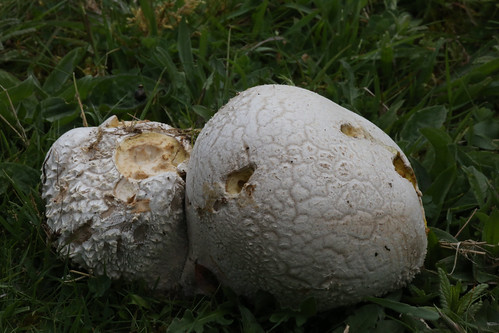Mosaic Puffball
(Bovistella utriformis)
Conservation • Description • Habitat • Ecology • Distribution • Taxonomy
Conservation Status |
|
|||||||
| IUCN Red List | not listed |
|||||||
| NatureServe | NNR - Unranked |
|||||||
| Minnesota | not listed |
|||||||
Description |
||
Mosaic Puffball is a large, common, and very widespread puffball. It is the second largest puffball in Minnesota. It occurs worldwide in the temperate zones of both the Northern and Southern Hemispheres. It occurs across North America but is mostly absent from the Great Plains. It is most common in the east, occasional in Minnesota. It is found from July to October in fields, meadows, pastures, shrubby areas, open woodlands, and woodland edges. It grows on the ground alone, scattered, or in groups. It obtains its nutrients from decaying organic matter (saprobic). When it first appears, the fruiting body is globe-shaped, white to cream-colored, and 2⅜″ to 4¾″ (6 to 12 cm) in diameter. The outer surface is densely covered with soft, fine, woolly hairs. As the puffball matures, it expands, it changes color, it develops a stem-like base, and the outer surface breaks up into a mosaic pattern of scaly, polygonal patches. This is the feature that gives the puffball its common name. Mature fruiting bodies are dull brown, pear-shaped, top-shaped, or pestle-shaped, 4″ to 10″ (10 to 25 cm) in height, and 2″ to 10″ (5 to 25 cm) in diameter. The upper part is often flat-topped and loaf shaped. Eventually, the upper part disintegrates from the center outward, forming a crater-like opening, and exposing the inner spore-bearing mass (gleba). The gleba is white, soft, and cheesy at first. It soon turns yellowish to olive, then finally olive brown or dark brown and powdery. It is edible only when it is pure white throughout. The upper part tapers gradually to the base. The base is very large and prominent, contributing up to one-half of the fruiting body’s total height. It persists long after the upper part has completely disintegrated and the spores have dispersed. The purplish-brown, cup-like, persistent base has fooled mycologists (and this writer) into believing it was a unique species. |
||
Similar Species |
||
Habitat and Hosts |
||
Fields, meadows, pastures, open woodlands, and woodland edges |
||
Ecology |
||
Season |
||
July to October |
||
Distribution |
||||
|
Sources |
|||
| 7/20/2023 | ||||
Occurrence |
||||
Common in the east, occasional in Minnesota |
||||
Taxonomy |
|||
| Kingdom | Fungi (fungi) | ||
| Subkingdom | Dikarya | ||
| Phylum | Basidiomycota (club fungi) | ||
| Subphylum | Agaricomycotina (jelly fungi, yeasts, and mushrooms) | ||
| Class | Agaricomycetes (mushrooms, bracket fungi, puffballs, and allies) | ||
| Subclass | Agaricomycetidae | ||
| Order | Agaricales (common gilled mushrooms and allies) | ||
| Suborder | Suborder Agaricineae | ||
| Family | Lycoperdaceae (puffballs) | ||
Genus |
Bovistella | ||
Order Family Genus |
|||
Synonyms |
|||
Bovista utriformis Calvatia caelata Calvatia utriformis Handkea utriformis Lycoperdon bovista Lycoperdon caelatum Lycoperdon utriforme Utraria utriformis |
|||
Common Names |
|||
Checkered Puffball Mosaic Puffball |
|||
Glossary
Gleba
The inner spore-bearing mass of puffballs, earthstars, and stinkhorns. The term is also used to refer to the spore-bearing slime covering the head of a stinkhorn.
Saprobic
A term often used for saprotrophic fungi. Referring to fungi that obtain their nutrients from decayed organic matter.
Visitor Photos |
|||||
Share your photo of this fungus. |
|||||
| This button not working for you? Simply email us at info@MinnesotaSeasons.com. Attach one or more photos and, if you like, a caption. |
|||||
Dan W. Andree |
|||||
Large Whitish Fungi... It didn’t have much of a stem. Maybe it’s one of those Puffball mushrooms. It was maybe 6-8 inches across. Never seen one before on a prairie. 7-6-23 Norman Co. MN. |
 |
||||
Mosaic Puffball... Here is another one … I was moving the grasses out of the way to show it better in this image. |
 |
||||
MinnesotaSeasons.com Photos |
|||||
|
|||||

Visitor Videos |
|||
Share your video of this fungus. |
|||
| This button not working for you? Simply email us at info@MinnesotaSeasons.com. Attach a video, a YouTube link, or a cloud storage link. |
|||
Other Videos |
|||
| Nature's Mosaic - Puffball NatureTalksandWalks |
|||
About
Jul 6, 2016 As part of 30 Days Wild by the Wildlife Trust, I'll be looking for one wild creature for each of the days of June and sharing it with you guys. As we approach the end of the series, we meet our first fungi - the bizarre Mosaic Puffball! Nature Talks and Walks is a mobile education service that offices wildlife workshops to schools, university, groups and as an adult speaker. To find out more, visit our website at www.naturetalksandwalks.co.uk Also don't forget to subscribe for more wildlife videos! |
|||
| Lycoperdon utriforme, mosaic puffball, stomach fungi, Calvatia utriformis Nature and consciousness |
|||
About
May 14, 2019 I go through the forests, mountains, hills, fields, and waters to understand the living world and to create a living mind. Lycoperdon utriforme, mosaic puffball, stomach fungi, Calvatia utriformis |
|||


Created: 7/20/2023
Last Updated:



